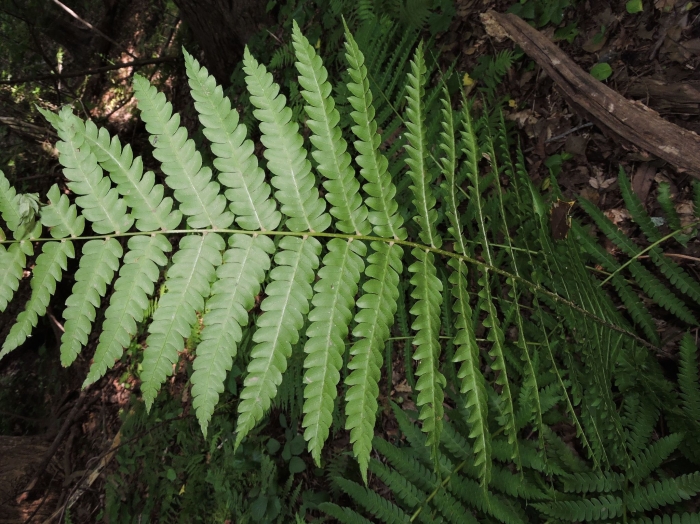Cinnamon Fern
(Osmundastrum cinnamomeum)
Cinnamon Fern (Osmundastrum cinnamomeum)
/
/

cwwood
CC BY-SA 4.0
Image By:
cwwood
Recorded By:
Copyright:
CC BY-SA 4.0
Copyright Notice:
Photo by: cwwood | License Type: CC BY-SA 4.0 | License URL: http://creativecommons.org/licenses/by-sa/4.0/ | Rights Holder: cwwood | Publisher: iNaturalist | Date Created: 2017-06-01T17:00:18-07:00 |


















































Estimated Native Range
Summary
Osmundastrum cinnamomeum, commonly known as Cinnamon Fern, is a deciduous perennial herb that thrives in the understory of moist, acidic forests, and is also found in bogs and wetlands across the Southeastern U.S., Northeastern South America, East Asia, and Southeast Asia. It typically forms clumps reaching 2-3 feet in height but can occasionally grow as tall as 5 or 6 feet. The fern is notable for its erect fronds and the distinctive cinnamon-colored fibrous covering on its fertile fronds, which appear in early spring and give the plant its common name. The foliage remains attractive throughout the growing season before dying back in the fall.
Cinnamon Fern is valued for its lush greenery and prehistoric appearance, making it a popular choice for shade gardens, woodland plantings, and naturalized areas. It is relatively easy to maintain, requiring consistently moist soil and protection from strong winds. While it prefers part shade to full shade, it can tolerate some morning sunlight if kept sufficiently moist. The fern is not typically prone to serious disease or pest problems, but overwatering or poor drainage can lead to root rot. It is also deer-resistant, which is a plus for gardeners in areas with high deer populations.CC BY-SA 4.0
Cinnamon Fern is valued for its lush greenery and prehistoric appearance, making it a popular choice for shade gardens, woodland plantings, and naturalized areas. It is relatively easy to maintain, requiring consistently moist soil and protection from strong winds. While it prefers part shade to full shade, it can tolerate some morning sunlight if kept sufficiently moist. The fern is not typically prone to serious disease or pest problems, but overwatering or poor drainage can lead to root rot. It is also deer-resistant, which is a plus for gardeners in areas with high deer populations.CC BY-SA 4.0
Plant Description
- Plant Type: Fern
- Height: 2-5 feet
- Width: 2-4 feet
- Growth Rate: Moderate
- Flower Color: N/A
- Flowering Season: Non-Flowering
- Leaf Retention: Deciduous
Growth Requirements
- Sun: Part Shade, Full Shade
- Water: Medium, High
- Drainage: Fast, Medium
Common Uses
Bird Garden, Deer Resistant, Low Maintenance, Rabbit Resistant, Water Garden
Natural Habitat
Moist, acidic forests, bogs, and wetlands
Other Names
Common Names: Buckhorn , Osmonde Cannelle , Kanelsafsa , Yamadori-Zenmai
Scientific Names: Osmundastrum cinnamomeum , Osmunda cinnamomea var. cinnamomea , Osmunda cinnamomea var. glandulosa , Osmunda cinnamomea var. fokienense , Osmunda cinnamomea f. glandulosa , Osmunda cinnamomea subsp. fokienense , Osmunda cinnamomea var. fokienensis , Osmunda cinnamomea
GBIF Accepted Name: Osmundastrum cinnamomeum (L.) C.Presl